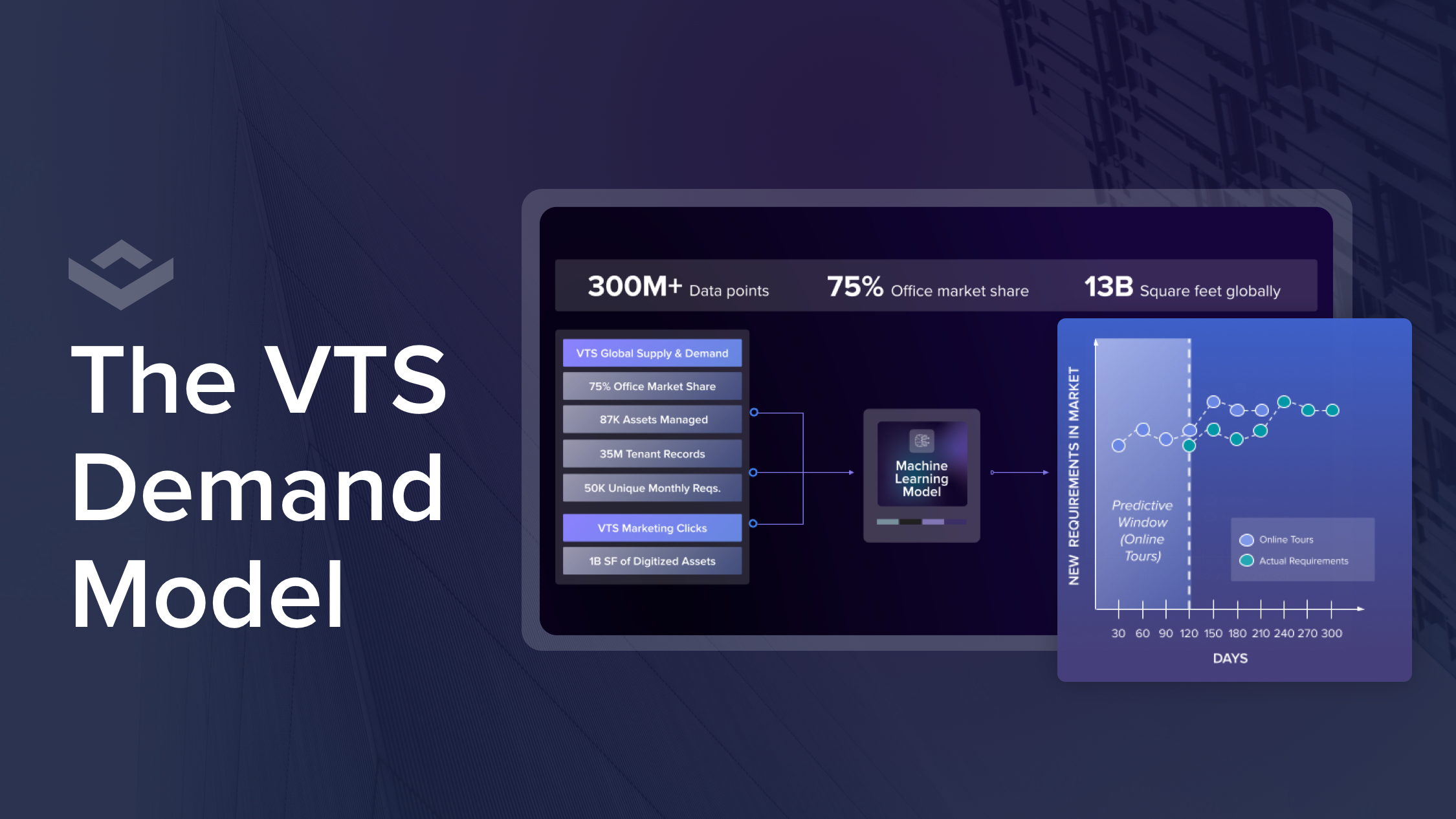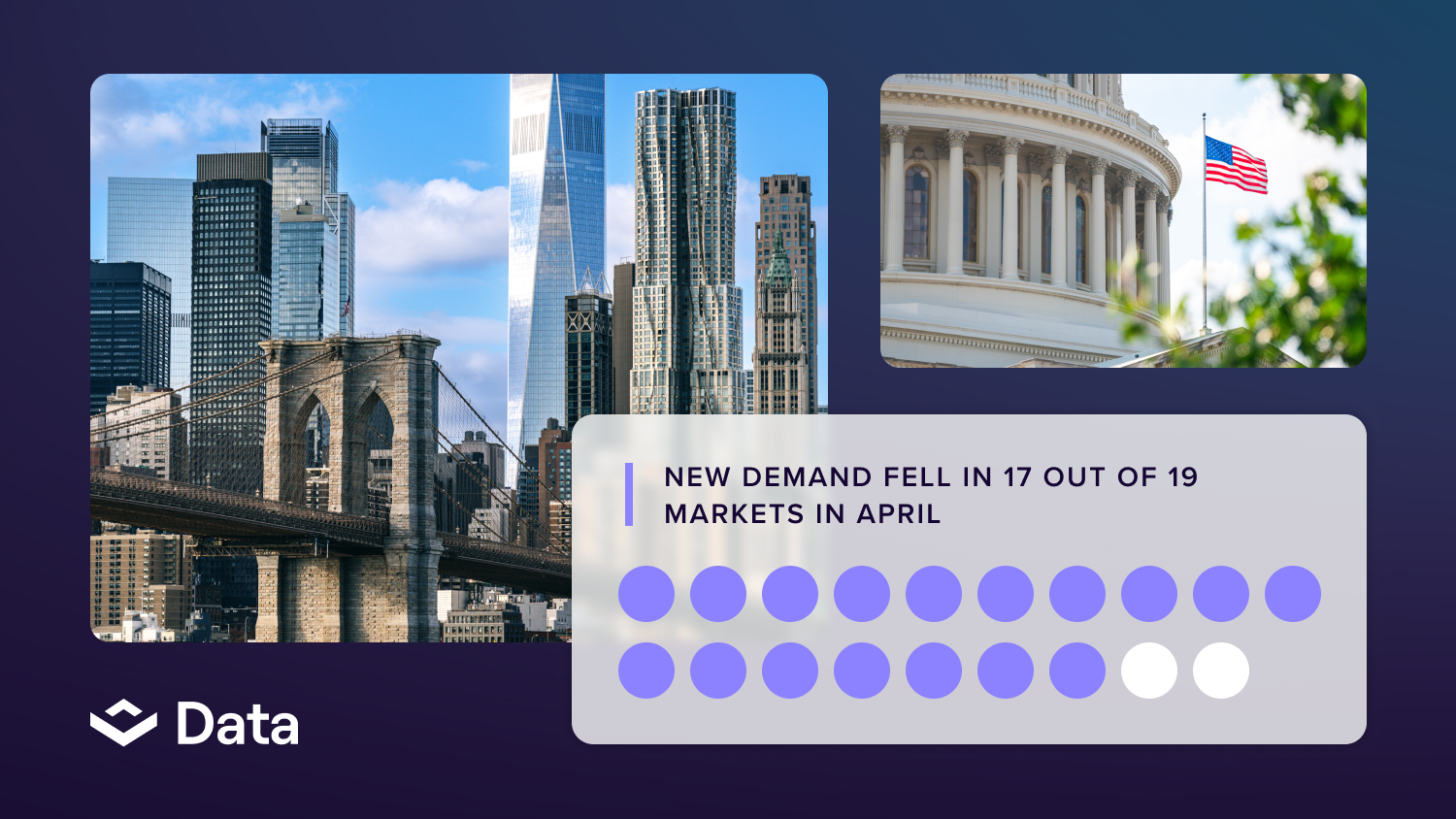What a transformation three and a half years makes.
You likely saw that we just announced VTS 4, which will give our customers the means to predict tenant demand for office space through enhanced data and AI-generated insights.
The “AI-generated insights” part is most exciting to me. The topic is now ubiquitous, but VTS has not been using AI for AI’s sake, nor data science for data science’s sake. What we have been doing – for years – is intentionally building a model that takes the scale of data VTS has about deals, tenants, spaces, buildings, and markets to give our customers what they really want from AI - which are answers. Answers to what tenant demand & pricing trends look like, and what they’re going to look like in the future.
The VTS Demand Model is the means to these answers, and we’re proud to publicly announce its development alongside VTS 4.
First, a little background, and why this announcement matters.
The CRE industry is built off of backwards-looking demand data. Trends develop up to a year and a half before stats are “recorded”. Due to quarterly reporting lags, it can be another 1-3 months before those stats are “reported” for consumption, analysis, and incorporated into an investment strategy.
This is a broken information model. We accepted it as the way things were because it worked in a period where the entire industry benefited from decades of cap rate compression, but that period could be over for good.
Three and a half years ago, I was approached by VTS with an opportunity to co-lead the creation of a predictive insights solution alongside a newly hired team of data scientists and researchers.
While I had known about VTS throughout my stints at CBRE, American Realty Advisors, and The Irvine Company, I was blown away by the promise of what “could be”. The ability to harness hundreds of millions of real-time data points across demand, pricing, and supply had the potential to be groundbreaking.
When learning about this opportunity, I thought to myself, “This is what everyone has been waiting for”. In my time as a researcher and economist, it always struck me that the datasets our industry works with to make leasing projections either account for factors external to leasing (think employment rate, population growth, etc.), or are reflective of the trends that happened months ago, if not over a year ago.
In other words, the data is incomplete and doesn’t capture the full universe of what’s happening on the ground, in granular detail, in real-time. Not only that, but you have the highest chance of making a forecasting error at turning points in the market – exactly when the need for accuracy and conviction is the greatest.
It’s not incidental that my time at VTS has run parallel with the re-establishment of the office market. To say the last three and a half years have been a rollercoaster for the office market is an understatement. Along with my team, I have been deeply committed to helping our customers navigate this period of time.
But we’re now at an inflection point. Office demand has been up for eight straight months, and the world’s savviest investors are once again engaging with their long-term office strategies. While there’s still risk, the next 18-24 months may prove to be one of the greatest periods in years to deploy capital into office.
To capitalize on this moment in time, we want our customers to have every informational and competitive advantage possible. The VTS Demand Model powers VTS 4, which unlocks the informational and competitive advantage our customers deserve.
What is the VTS Demand Model?
I’ve grappled a lot with how to describe the VTS Demand Model in simple terms. It can be heady stuff, and ultimately the outcomes the model drives are what’s most important. So, instead of providing one blanket way to unpack this, I’ll explain what the model is as if I’m talking to three different people: A (curious) third grader; a first-year broker; and a CRE executive.
- Curious Third Grader Explanation: The VTS Demand Model takes all of our information, puts it together, and allows us to see the future based on that information.
- First-Year Broker Explanation: The VTS Demand Model is a series of AI tools that work together to produce insights using 300 million data points. These insights will help you lease more space, because you’ll be able to predict drivers of leasing activity 6-9 months ahead of metrics your competition uses, and also see when prospects are interested in your buildings 90-120 days before they start physically touring space.
- CRE Executive Explanation: The VTS Demand Model uses AI to...
1. Refine real-time global supply & demand data, pricing data, and marketing analytics
2. Make connections across those datasets to produce relevant insights for your portfolio
3. Give you the predictive data required to pursue investment and leasing decisions faster - and with more conviction - than ever before
Hopefully that sums it up nicely (a few times). You might be wondering about the AI part, though, and how it applies to the Demand Model. Let’s get into it.
How is AI applied in the VTS Demand Model?
There are three categories of AI use cases within the VTS Demand Model. These categories are refinement, personalization, and prediction.
- Refinement: You might have heard that we’re harnessing 300 million data points across 13 billion square feet of assets to produce insights. But much like how crude oil needs to be refined in order to be usable, data needs to go through a refining process to be turned into something accurate and actionable.
In our case, refinement means taking our universe of leasing data and ensuring those data points are properly categorized, and then linked, as real world entities - think “property”, “tenant”, “deal”, “requirement”, etc. As part of the VTS Demand Model, we use Natural Language Processing (NLP) and machine learning to refine and link this data at 5X the speed and at a fractional cost of relying on human capital.
This refinement is very important when considering one its primary implications. To provide an accurate, real-time lens into tenant demand within individual markets, we need to make sure overall office demand is not overstated. By using machine learning to link real-time touring activity from a single tenant to a single requirement, we can ensure multiple tours from the same tenant do not appear as multiple requirements.
- Personalization: Let’s say a tenant is, in fact, touring multiple spaces and has a known requirement. Wouldn’t it be great to know if that tenant has toured your space, and if you already have a relationship with that tenant elsewhere in your portfolio?
That’s where AI comes in again. By using machine learning to “link” a tenant’s tour to one of your buildings - and link that building to your portfolio - we’re able to instantly surface your existing relationship with that tenant.
Our use of AI to personalize insights is even more powerful when it comes to tenant requirements not yet known to the market. Over the last few years we’ve seen that, on average, prospective tenants look at space online 90-120 days before they begin physically touring space and their requirement is known. Not only can we capture the companies looking at your spaces online, but with AI we’re once again able to surface whether you have an existing deal or relationship with that tenant.
- Prediction: This one is surprisingly simple. It’s one thing for us at VTS to report tenant demand trends in real-time (and that’s already unique to us); it’s another to predict what demand is going to look like in the coming months.
By using AI to train our algorithms on a decade’s worth of “ground truth” data, we are now in a place where The VTS Demand Model can predict the likelihood of a prospect becoming a lead with a concrete requirement. In a market where leasing teams need every edge possible to prospect aggressively, lead forecasting presents an opportunity to uncover deal opportunities that would otherwise be missed or overlooked.
This is only the beginning.
Today we’re making use of our global supply, demand, pricing, and marketing analytics data. Soon we’ll be able to innovate with data in an exponential manner, bringing into our model all of the tenant experience and property operations data created through VTS Activate.
We’re beyond excited for the promise of the VTS Demand Model. What a transformation three and a half years makes.






